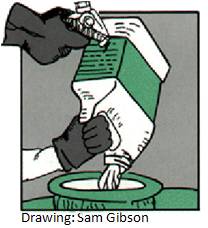Why would you want to leave any product in the container? Leaving six ounces in a 2.5-gallon container is a loss of 2%. If the product costs you $250, that is five dollars wasted. This loss is greatly compounded by the need to handle the unrinsed container as a hazardous waste (EPA, DOT, state environmental agency oversight and expense). However, there are state programs and companies that can assist you with hazardous wastes.
 It is strongly recommended that you rinse containers immediately after emptying them to ensure that the containers are sufficiently clean. A delay in rinsing can result in dried, caked residues that may be very difficult, if not impossible, to rinse clean. Visit the ACRC website to view a video on pressure or triple rinsing smaller containers or drums.
It is strongly recommended that you rinse containers immediately after emptying them to ensure that the containers are sufficiently clean. A delay in rinsing can result in dried, caked residues that may be very difficult, if not impossible, to rinse clean. Visit the ACRC website to view a video on pressure or triple rinsing smaller containers or drums.
Plastic recycling companies, solid waste facilities, and incineration facilities require pesticide containers to be properly rinsed. Some companies or facilities may require you to sign a document to verify the containers were triple or pressure rinsed. In rare instances, triple-rinsed pesticide containers are turned away from disposal facilities.
ACRC has excellent resources for learning how to properly handle your containers and illustrates what types of issues impact whether a container is accepted for recycling; visit their website.
Pressure-Rinsing
Consider eye protection when pressure rinsing non-refillable containers (plastic or metal). Attach a special nozzle to the end of a hose. The special nozzle has an on/off valve, and when “on”, the water released by the nozzle forces the pesticide residues from the container. Rinse directly into your spray batch. Some people think pressure-rinsing is faster and easier than triple-rinsing.
Directions
- When you empty a container, allow it to drain into the spray tank for 10 seconds after it begins to drip.
- Remove the guard from the pressure-rinse nozzle, which is connected to a water hose.
- Place the container against a hard object and puncture the side or bottom of the container carefully. Do not puncture against your leg. Either puncture the:
- narrow side with the handle near the bottom of the container, or
- bottom of the container near the handle side (not the opening side).
- Hold the container upside down with the pour spout over the sprayer tank opening so the rinsate drains directly into the sprayer tank.
- Rinse for the length of time recommended by the manufacturer (generally 30 seconds or more). Rotate the nozzle to rinse all inside surfaces.
- Take care to make sure hollow handles are well rinsed.
- Rinse the cap, leave it removed, and dispose of it in normal refuse.
- Allow clean container to dry. Store for later recycling or disposal.
Triple-Rinsing
This does not require any special equipment and can be used with plastic, non-pressurized metal, and glass containers. Triple rinse when you empty the container.
Directions
 Empty the pesticide into the spray tank, and allow it to drain for 10 seconds after it begins to drip.
Empty the pesticide into the spray tank, and allow it to drain for 10 seconds after it begins to drip.- Fill the container ¼ full of water, and securely replace the cap.
- Shake for 10 seconds to rinse all inside surfaces.
- Pour rinsate into application equipment, and allow the container to drain for 10 seconds after it begins to drip.
- Repeat steps 2 through 5 two more times.
- Rinse the cap, leave it removed, and dispose of it in normal refuse.
- Allow clean container to dry. Store for later recycling or disposal.
Compiled by Carol Ramsay
